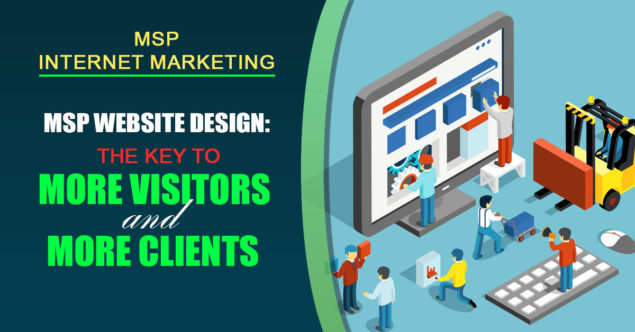- You are here:
- Home »
- Blog »
- MSP Management »
- MSP Website Design – The Key to More Visitors and More Clients

MSP Website Design – The Key to More Visitors and More Clients
Internet marketing is just one side of the coin to get more clients. In our previous article, we’ve talked about how you can increase traffic in your website. And on another one, how your MSP website can generate leads to convert into sales. But what’s equally important also in getting more clients online is your MSP website design. So we’ll dive into these three aspects of your site – the importance of keeping it simple, and the appeal of its being responsive and friendly to mobile surfers.
Your MSP website can draw more customers compared to any other form of traditional marketing. However, it must be well-designed and have the right information so you can a higher chance of converting your visitors into clients.
Simplicity in Your MSP Website Design
Some websites have impressive graphics design. And they really can draw attention. This works well if you only aim to catch the attention of your web visitors, and nothing else. Catching attention is good, but holding it is another thing. On average, you only have about seven seconds to make your visitors decide if they want to stay in your website or move on to your competition. If you have a cluttered website, it’s easy for visitors to lose interest and go somewhere else. And if it’s difficult for them to figure out how you can help them, then it’s also a lost opportunity.
So while attention-grabbing graphics play some role, there’s more to it when you want to gain more clients through your website. Here are several helpful dos and don’ts to consider for a simple and straightforward website.
The Do’s
Fast loading time. You can show that you value your visitor’s time by making sure that your website loads fast. When a visitor checks out your MSP website, the first five to seven seconds is crucial in catching their attention. If your site’s loading time takes longer than that, then your visitors are mostly likely to look for what they need elsewhere.
Use a headline. A headline in your homepage is helpful for new visitors. Your headline should tell something of what you do, and your location. For example, “Managed IT Provider in California.” This information is helpful to potential clients and the location info can catch their attention right away.
Use simple terms. Technical terms and industry jargons are easily understood among technicians. But for your clients, it may take some time to figure out what you mean by RMM or cloud computing. So use words that your website visitors can understand. Doing so makes it clear right away if you have the solution that your potential client is looking for.
Pre-sell your products and services. It’s not enough to just tell your website visitors that you have this plan and this is the price. To really help them make a decision, talk about how your services can help them. What will they get from it? Also, be detailed about payments – if it is monthly or yearly. It’s better to lay your cards straight on the table, than to leave potential clients guessing about your prices and services.
Provide your contact details on every page. You never know on which page your website visitor will come to a decision to become your client. If your visitor comes to that point and find it hard to get your contact details then it might be a lost opportunity. Ideally, it’s better to provide your email or phone number on every page. And put it in a place where the eye can easily find it.
Call to action. This is the most important element of your MSP website design. This is the conclusion of your visitor’s surfing experience. In effect, this should be the flow of your website: catch visitor’s attention, hold their attention by pre-selling your services, call them to act, then convert into sales.
Without the call to action element, it’s difficult to convert your website surfers into clients. So make sure you show them the next step when they find what they are looking for in your website. Either your site should be able to close the sale, or get their contact information so you can close the sale later.
The Don’ts
Don’t encourage leaks in your msp website design. You’ve spent so much time and effort in drawing visitors in. It’s counterproductive to point them somewhere else. So as much as possible, avoid links that unnecessarily take people away from your MSP website.
Don’t write down your resume under your offered services. You don’t want to clutter your MSP website with unnecessary information. Current projects and numerous certifications will have little meaning to your visitors in this section. Instead, you would want to have a bullet list of your services. Notice how the following list uses words that are easily understood and how it includes the benefits of the service.
Our managed services include:
- Hardware monitoring to avoid downtime
- Regular scheduled backup to secure files
- Testing and monitoring for cyber security
- Unlimited consultation for IT solutions
- Business continuity plan for disasters
Don’t put distractions such as a search option. If your search engine only looks into your website, then this is helpful for you visitors. It allows them to quickly find what they are looking for, while keeping them in your website. But if your search feature includes external links in the result, then it’s not a good idea. Again, this defeats your efforts of bringing more traffic into your MSP website if the search leads your visitors somewhere else.
Don’t use too many words when talking about your business. Remember, your web visitors are there trying to find a solution for their IT problem. If you need to talk about you and what you do, then keep it short and simple. If you don’t know where to start, you can try to write down everything you want to say. Then you can choose three best sentences from the list. These sentences should best represent you and what you do.
Don’t talk technical jargon in your website. It’s easy to talk about “industry grade”, “3rd party software”, or “updates”. But to your clients who are end-users, these words have little to no appeal. See the difference below.
“All your updates for Windows and 3rd party programs like Java, Adobe Reader, and Adobe Flash, etc.” – This is okay for technicians and techie users.
“Keeping your software up to date and secure.” – This is more appealing to basic-users, and for the decision-makers as well.
Now that we’ve covered several dos and don’ts for your MSP website design, let’s talk about reaching more people by making your website responsive.
Make It Responsive to Mobile Users
Mobile is the new desktop. The rise in popularity of mobile devices in our time is indeed phenomenal. It’s widely used today, by people from all walks of life. It would be lost opportunity for you if your MSP website design is not responsive and do not adjust to mobile and other devices.
On the other hand, there are several benefits when you have a responsive MSP website design.
Allows you to reach people on the go. In the past, you need to create a separate version of your website if you want to draw in mobile users. This doubles your time and effort to maintain both sites. It could cost you more too. While many businesses today still do this, technology has improved since then. Today, you can have just one responsive MSP website that can deal with all devices.
Of course, business owners may not make the big decision of converting into your clients while they are on the go. But being able to catch them while they are using their mobile device gives you a first-base opportunity. You have that visibility when they are in their search stage. And when they have the time to sit down and make the decision, your mobile visibility earlier allows you to be on their list of IT solution providers.
Lower cost and less hassle. Lesser maintenance cost, and less effort. These are other benefits of your responsive MSP website design. It may cost you more at the start, but the reduced cost on maintenance will spell out the big difference. Having just one website means it takes less time to set-up, and less time to maintain. And this is what’s really important – your time. With more free time, you can focus on other important areas of your business.
Smooth user experience. If your MSP website appears to be missing something, or distorted, then you are most likely to lose potential clients. It becomes a pain when texts are jumbled, images do not align and users have to scroll through endless pages in search of the information they need.
After this kind of experience, you not only lose a potential client but they are unlikely to come back to your website. On the other hand, a responsive website adjusts accordingly. This is one of its greatest benefits. And in the long run, the benefits will outweigh whatever you’re going to spend on it in the beginning.
Helps improve your search ranking. Responsive websites have a greater likelihood of ranking higher in search results. SEO helps bring in more traffic into your MSP website, and your user-focused MSP website design helps to make visitors dwell a little longer. Google recommends a responsive website design for better SEO.
A simple, straightforward, and responsive MSP website design gives you a leverage in attracting more visitors and eventually converting them into clients. If you don’t know how to get started, our website analysis can provide valuable assistance.
PS: If you need content for your websites blog, check out our White-Label Newsletter Service. Not only does it provide newsletter content, but you can post those articles your blog and social media accounts too.

TECHNIBBLE MARKETING MEMBERSHIP
MSP Marketing Training and Done-for-You Content to Gain New Leads and Reactivate Existing Clients.
